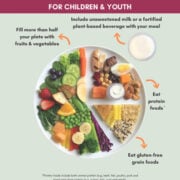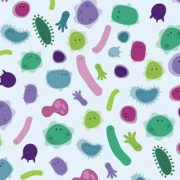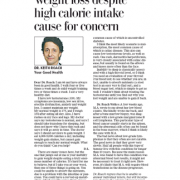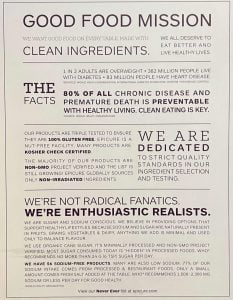Possible Marker Could Help Diagnose Non-Celiac Gluten or Wheat Sensitivities
 The presence of duodenal and rectal eosinophils, in the absence of endoscopic findings, could be a marker of non-celiac gluten or wheat sensitivity (NCGWS), new research suggests.
The presence of duodenal and rectal eosinophils, in the absence of endoscopic findings, could be a marker of non-celiac gluten or wheat sensitivity (NCGWS), new research suggests.
- Nicola Garrett, Internal Medicine News 1
NCGWS could be considered an inflammatory condition of the entire intestinal track and the eosinophil infiltration “may represent a key candidate player” in its pathogenesis, wrote the authors, led by Antonio Carroccio, MD, of Giovanni Paolo II Hospital, Sciacca, and DiBiMIS University of Palermo, Italy.
- Key clinical point: The evaluation of patients for nonceliac gluten or wheat sensitivity should include histologic analysis of rectal biopsies.
- Major finding: Mucosal inflammation in the duodenum and in the rectal mucosa was common in patients with NCGWS. In these patients the mean eosinophil infiltration was more than 2.5-fold the upper normal limit in the rectum and nearly twice the upper normal limit in the duodenum (P less than .0001).
- Study details: A prospective study of 78 patients with NCGWS and 55 controls with either celiac disease or self-reported NCGWS but negative wheat challenge results.
The research team noted that duodenal histology, a lack of villous atrophy, and evaluation of intraepithelial infiltration of the duodenal mucosa were the usual steps involved in the diagnostic work-up of NCGWS.
Many people with NCGWS had symptoms that overlapped with irritable bowel syndrome but no studies had evaluated histologic features of duodenal and rectal biopsies from these patients.
“Alterations of the mucosal immune system are believed to play a role in IBS and some patients may indeed have inflammation of the colonic mucosa. Consequently, it would be logical to study the colon of NCGWS patients for possible inflammation in this site,” they wrote.
The current study involved 78 consecutive adult patients attending two tertiary referral centers in Italy. The average age of the patients was 36.4 years and they were diagnosed with NCGWS through a double-blind wheat challenge. A non-NCGWS control group of 55 patients had either celiac disease (n = 16) or self-reported NCGWS but with negative results from the wheat challenge (n = 39).
Both duodenal and rectal biopsies were performed in both groups of patients after they had consumed a wheat-containing diet (a minimum of 100 g) for at least 4 weeks.
The researchers then analyzed intraepithelial CD3+T cells, lamina propria CD45+ cells, CD4+ and CD8+ T cells, mast cells, and eosinophils as well as the presence and size of lymphoid nodules.
Histologic evaluation of the duodenal mucosa showed that none of the NCGWS patients or non-NCGWS controls had a villus/crypt ratio less than 3, whereas all the controls with celiac disease (CD) had villous atrophy.
Mucosal inflammation both in the duodenum and the rectal mucosa was common in patients with NCGWS. For example, intraepithelial CD3+ lymphocytes progressively increased from the non-NCGWS controls (14.3 ± 4.2) to NCGWS patients (19.6 ± 10.7; P less than .03) and CD controls (47.7 ± 23.3; P less than .001 vs. NCGWS patients).
Lamina propria CD45+ cells, which the authors said represented the “total immunocyte” infiltration were significantly higher in NCGWS patients than in the non-NCGWS controls at both sites.
In patients with NCGWS, the mean eosinophil infiltration was more than 2.5-fold the upper normal limit in the rectum and nearly twice the upper normal limit in the duodenum (Pless than .0001).
Eosinophil numbers in the duodenal mucosa were also higher in the NCGWS patients with dyspepsia than in the NCGWS patients without upper digestive tract symptoms.
For example, in 33 patients who reported upper digestive tract symptoms, the number of lamina propria eosinophils was significantly higher than in the remaining NCGWS patients who did not report symptoms (8.6 ± 2.6 vs. 6.8 ± 3.6; P less than .01).
“Functional dyspepsia is frequently associated with IBS [irritable bowel syndrome], suggesting that these two diseases have a shared pathogenesis,” the researchers speculated.
The researchers suggested that in the absence of endoscopic findings, eosinophil infiltration of the rectal mucosa could be a marker of NCGWS, noting that it could not be considered a specific marker as eosinophils were found in the colon and rectal mucosa in several clinical conditions, such as inflammatory bowel diseases and celiac disease.
“However, these clinical conditions have clinical, endoscopic, serologic, and histologic aspects markedly different from NCGWS. … We would suggest that in clinical practice, subjects showing an IBS clinical presentation and mucosa eosinophil infiltration should be recommended to commence an elimination diet with a subsequent wheat challenge,” they said.
The authors said another noteworthy finding from their study was that about 95% of patients had lymphoid follicles that were significantly larger than those of the control group. Although this can be considered a “normal” finding in rectal mucosa, they said in their experience the presence of large follicles was associated with non-IgE mediated food allergy.
“It can be hypothesized that not only eosinophils could play a pathogenetic role in NCGWS, and that a complex immunologic response involving both innate and acquired immunity may be responsible for this disease,” they said.
A study limitation was selection bias stemming from the fact that the cohort included patients referred to tertiary centers, they noted. “Our results must not be extended to all self-treated or diagnosed NCGWS patients,” they cautioned.
SOURCE: Clin Gastroenterol Hepatol. 2018 Aug 20. doi: 10.1016/j.cgh.2018.08.043.













